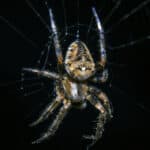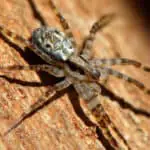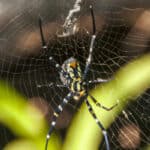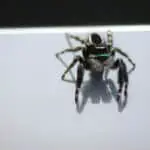Have you ever come across a spider and wondered if it was pregnant? It can be difficult to tell, but there are a few key characteristics to look out for. In this article, I will explore the topic of spider pregnancy and provide you with some tips on how to identify a pregnant spider.
Understanding spider reproduction is crucial to identifying a pregnant spider. Spiders have a unique reproductive system that involves the male spider depositing sperm into the female spider’s body. The female then stores the sperm and uses it to fertilize her eggs when she is ready to lay them. Once a female spider becomes pregnant, she will produce an egg sac that holds many eggs. The egg sac is usually round and smooth and is attached to the spider’s web.
Identifying a pregnant spider can be tricky, but there are a few telltale signs to look out for. One of the most obvious signs is an enlarged abdomen. The female spider’s abdomen will become larger as she carries her eggs. Another sign is hormonal changes, which can be detected through testing. Additionally, some species of spiders have specific characteristics that can help you identify a pregnant spider.
Key Takeaways
- Understanding spider reproduction is crucial to identifying a pregnant spider.
- An enlarged abdomen and hormonal changes are common signs of spider pregnancy.
- Different species of spiders have unique characteristics that can help you identify a pregnant spider.

Understanding Spider Reproduction
As someone who is interested in identifying pregnant spiders, it’s important to have a basic understanding of spider reproduction.
Spiders are part of the arachnid family, and their reproductive system is quite different from that of mammals. Unlike mammals, spiders have separate reproductive organs. The male spider has reproductive openings called pedipalps that are used to transfer sperm to the female spider.
During mating, the male spider will produce a sperm web, which is a small web that he uses to transfer his sperm to his pedipalps. Once the sperm is transferred, the male spider will insert his pedipalps into the female spider’s reproductive opening and deposit the sperm.
Female spiders are sexually mature once they reach adulthood, and they can produce eggs throughout their entire life. When a female spider is ready to lay eggs, she will produce an egg sac. The egg sac is smooth and round, and it’s attached to the spider’s web.
It’s important to note that not all female spiders will produce egg sacs. Some species of spiders will lay their eggs directly onto their web, while others will carry their eggs with them until they hatch.
In conclusion, understanding spider reproduction is important if you want to identify pregnant spiders. Knowing how spiders mate and produce eggs can help you identify the signs of pregnancy, such as a swollen abdomen or the presence of an egg sac.
Identifying a Pregnant Spider
As a spider enthusiast, I know how exciting it can be to discover a pregnant spider. But how do you know if a spider is pregnant? Here are a few things to look for:
Enlarged Abdomen
One of the most noticeable signs of a pregnant spider is an enlarged abdomen. When a spider is carrying eggs, its abdomen will become round and noticeably larger than its non-pregnant counterparts. However, it’s important to note that a bloated abdomen can also mean that the spider has recently consumed a large meal. So, it’s always best to look for additional signs of pregnancy.
Egg Sac
When a female spider is pregnant, she will produce an egg sac, which holds many eggs. The egg sac is smooth and round and is attached to the spider’s web. If you see a spider with an egg sac, it’s a sure sign that she is pregnant. It’s worth noting that not all spider species produce egg sacs, so this is not a foolproof method of identifying a pregnant spider.
Female Spiders
In most spider species, it’s only the female spiders that become pregnant. The female spider’s reproductive openings are situated on the underside of her abdomen, where the pedipalps, which can produce sperm, are inserted. So, if you see a spider with an enlarged abdomen and you know it’s a female, there’s a good chance she’s pregnant.
Spider Species
Different spider species have different ways of reproducing, so it’s important to know the specific characteristics of the species you’re dealing with. For example, tarantulas are known for their noticeable abdominal swelling when pregnant, while some orb-weaving spiders may not show any visible signs of pregnancy at all.
In summary, identifying a pregnant spider requires careful observation of its physical characteristics and behavior. Look for an enlarged abdomen, the presence of an egg sac, and consider the species you’re dealing with. With a little practice, you’ll be able to spot a pregnant spider in no time!
Species Specific Characteristics
When it comes to identifying whether a spider is pregnant or not, there are a few species-specific characteristics to look out for. Here are some common spiders and their unique pregnancy characteristics:
Jumping Spiders
Jumping spiders are known for their incredible jumping ability and are one of the most common spider species. However, it can be challenging to identify whether a jumping spider is pregnant or not. One of the best ways to identify a pregnant jumping spider is by observing their behavior. Pregnant jumping spiders tend to be less active and move around less frequently than their non-pregnant counterparts.
Wolf Spiders
Wolf spiders are another common spider species found in many parts of the world. These spiders are known for their hunting ability and can be identified by their characteristic eye arrangement. To identify a pregnant wolf spider, you need to look at their abdomen. Pregnant wolf spiders have a round, swollen abdomen that is more prominent than their non-pregnant counterparts.
Huntsman Spiders
Huntsman spiders are known for their large size and speed. These spiders are commonly found in tropical and subtropical regions. To identify a pregnant huntsman spider, you need to look at their abdomen. Pregnant huntsman spiders have a round, swollen abdomen that is more prominent than their non-pregnant counterparts.
Brown Recluse Spiders
Brown recluse spiders are known for their venomous bite and are commonly found in the southern and central regions of the United States. To identify a pregnant brown recluse spider, you need to look at their abdomen. Pregnant brown recluse spiders have a round, swollen abdomen that is more prominent than their non-pregnant counterparts.
Black Widow Spiders
Black widow spiders are known for their venomous bite and are commonly found in temperate regions worldwide. To identify a pregnant black widow spider, you need to look at their abdomen. Pregnant black widow spiders have a round, swollen abdomen that is more prominent than their non-pregnant counterparts.
House Spiders
House spiders are a common species found in homes worldwide. To identify a pregnant house spider, you need to look at their abdomen. Pregnant house spiders have a round, swollen abdomen that is more prominent than their non-pregnant counterparts.
Crab Spiders
Crab spiders are known for their ability to change color and blend in with their surroundings. These spiders are commonly found in gardens and on flowers. To identify a pregnant crab spider, you need to look at their abdomen. Pregnant crab spiders have a round, swollen abdomen that is more prominent than their non-pregnant counterparts.
Tarantulas
Tarantulas are a popular pet spider species and are known for their large size and hairy appearance. To identify a pregnant tarantula, you need to look at their abdomen. Pregnant tarantulas have a round, swollen abdomen that is more prominent than their non-pregnant counterparts.
Overall, identifying whether a spider is pregnant or not can be challenging, but by looking at their behavior and abdomen, you can get a good idea. Remember that not all species have the same characteristics, so it’s essential to do your research and learn about the specific spider species you are interested in.
The Life Cycle of a Spider
Spiders have a fascinating life cycle that consists of three stages: egg, spiderling, and adult. Each stage varies in length and complexity, depending on the species of spider.
The first stage of a spider’s life cycle is the egg stage. After mating, the female spider lays her eggs, which are usually wrapped in an egg sac made of silk. The number of eggs in each sac varies depending on the species, ranging from just a few to hundreds or even thousands of eggs.
Once the eggs hatch, the spiderlings emerge and enter the second stage of their life cycle. During this stage, the spiderlings molt several times as they grow and develop. They also begin to hunt and feed on small insects and other prey.
The final stage of a spider’s life cycle is the adult stage. Adult spiders are fully grown and have reached sexual maturity. They continue to hunt and feed, and they may also mate and lay eggs to start the cycle anew.
Throughout their life cycle, spiders rely on silk for a variety of purposes. They use silk to construct egg sacs, to create webs for catching prey, and to protect themselves from predators.
In conclusion, the life cycle of a spider is a fascinating and complex process that involves multiple stages and the use of silk for a variety of purposes. By understanding the different stages of a spider’s life cycle, we can gain a greater appreciation for these amazing creatures and the important role they play in our ecosystem.
What Happens If a Pregnant Spider is Killed
Have you ever killed a spider and wondered if it was pregnant? If so, you may be wondering what happens when you kill a pregnant spider.
When a pregnant spider is killed, it’s possible that its babies will scatter away. Spiders tend to lay many eggs, and it’s a survival strategy to ensure that at least a few survive.
However, the babies may not survive if they are not grown enough to scatter away when the mother dies. It’s also important to note that spiders are not insects, but rather arachnids.
It’s important to be mindful of killing spiders, especially if you suspect that they may be pregnant. If you’re concerned about spiders in your home, consider using humane methods to remove them, such as catching them in a jar and releasing them outside.
Remember, spiders play an important role in our ecosystem by controlling insect populations. So, before you reach for the bug spray, think about the impact it may have on the environment.
Spider Courtship and Mating Rituals
Have you ever wondered how spiders mate? In this section, I will give you a brief overview of spider courtship and mating rituals.
First of all, male spiders usually initiate courtship by producing pheromones to attract females. Once a female has been attracted, the male will approach her and begin to perform a series of movements and vibrations to communicate his intentions. These movements can vary depending on the species of spider, but they often involve leg tapping, leg waving, and body vibrations.
If the female is receptive to the male’s advances, she will respond with her own movements and vibrations. This can lead to a complex dance between the two spiders, with each one responding to the other’s movements.
Once the male has successfully courted the female, he will attempt to mate with her. This can be a dangerous process for the male, as the female may see him as a potential meal rather than a mate. To avoid being eaten, the male will often use specialized appendages to hold the female’s jaws open while he mates with her.
After mating, the female will lay her eggs in an egg sac, which she will guard until they hatch. The male will usually move on to find another mate.
In conclusion, spider courtship and mating rituals can be complex and fascinating to observe. By understanding these rituals, we can gain a deeper appreciation for these amazing creatures.
Predators and Threats to Spiders
Spiders are fascinating creatures that play a vital role in the ecosystem. However, they are not without their share of predators and threats. As a spider enthusiast, it’s essential to understand these threats to help protect these arachnids.
Predators of Spiders
Spiders have many natural predators, including birds, reptiles, amphibians, and other insects. Some of the most common predators of spiders include:
- Birds: Many bird species, such as the blackbird and the crow, feed on spiders.
- Lizards: Some lizards, such as the chameleon and the gecko, are known to eat spiders.
- Frogs and toads: These amphibians are common predators of spiders, especially those that live near water bodies.
- Insects: Some insects, such as the praying mantis and the assassin bug, feed on spiders.
Threats to Spiders
Apart from predators, spiders also face other threats that can affect their survival. Some of these threats include:
- Pesticides: The use of pesticides in agriculture and homes can be harmful to spiders.
- Habitat destruction: Destruction of natural habitats, such as forests and wetlands, can lead to a decline in spider populations.
- Climate change: Changes in temperature and rainfall patterns can affect the distribution and abundance of spider species.
- Human persecution: Spiders are often misunderstood and feared by humans, leading to their persecution and killing.
As spider enthusiasts, it’s crucial to take steps to protect these fascinating creatures. We can do this by avoiding the use of pesticides, supporting conservation efforts, and educating others about the importance of spiders in our ecosystem.
Further Reading and Resources
If you’re interested in learning more about how to tell if a spider is pregnant, there are a variety of resources and further reading available online. Here are a few recommendations to get you started:
Resources
Spider Identification Guide: This comprehensive guide from Pest World provides information on a wide variety of spider species, including details on their appearance, habitat, and behavior. It also includes tips for identifying spiders based on their physical characteristics, such as the shape of their abdomen.
Spider Anatomy Chart: This detailed chart from Terminix provides an overview of the different parts of a spider’s body, including their legs, eyes, and spinnerets. It can be a helpful resource for understanding how spiders are built and how they function.
Spider Egg Sac Identification Guide: This guide from Spider ID provides information on how to identify different types of spider egg sacs based on their appearance and location. It also includes photos to help you compare and contrast different types of egg sacs.
Further Reading
“Spiders: The Ultimate Guide” by Jinny Johnson: This book provides an in-depth look at the world of spiders, including their behavior, anatomy, and life cycle. It also includes information on different types of spiders and their habitats.
“The Private Life of Spiders” by Paul Hillyard: This book takes a closer look at the behavior and habits of spiders, including their mating rituals, hunting strategies, and social interactions.
- “The World of Spiders” by Rainer F. Foelix: This book provides a comprehensive overview of the world of spiders, including information on their anatomy, behavior, and ecology. It also includes detailed photos and illustrations to help you better understand these fascinating creatures.
Whether you’re a spider enthusiast or just looking to learn more about these fascinating creatures, these resources and further reading options can provide you with the information you need to better understand how to tell if a spider is pregnant.
Frequently Asked Questions
How can you tell if a spider is pregnant?
You can tell if a spider is pregnant by observing its abdomen. A pregnant spider will have a noticeably larger and rounder abdomen than non-pregnant spiders. The swelling is due to the spider filling up with eggs. This symptom is more evident in spiders that can be kept as pets or observed in the wild, such as tarantulas.
What are the signs that a spider is carrying eggs?
The most evident sign that a spider is carrying eggs is the presence of an egg sac. The egg sac is a smooth and round structure attached to the spider’s web. The spider will carry the egg sac with her until the eggs hatch. Additionally, a pregnant spider will exhibit abdominal swelling as she fills up with eggs.
What does a pregnant black widow spider look like?
A pregnant black widow spider will have a noticeably larger and rounder abdomen than non-pregnant black widow spiders. However, it is important to note that identifying a black widow spider can be challenging as they are often confused with other spider species.
How do you identify a gravid jumping spider?
Gravid jumping spiders are identified by observing their behavior. A gravid jumping spider will be less active and move more slowly than non-pregnant jumping spiders. Additionally, a gravid jumping spider will have a larger and rounder abdomen than non-pregnant jumping spiders.
What happens when a spider becomes pregnant?
When a spider becomes pregnant, it will produce an egg sac to hold the eggs. The spider will carry the egg sac with her until the eggs hatch. During this time, the spider will exhibit abdominal swelling as she fills up with eggs.
Is it safe to kill a spider that is pregnant?
It is not recommended to kill a spider that is pregnant. Instead, capture the spider in a jar along with its egg sac and release it outside. Killing a pregnant spider can result in the loss of hundreds of spiderlings that would have hatched from the egg sac.








